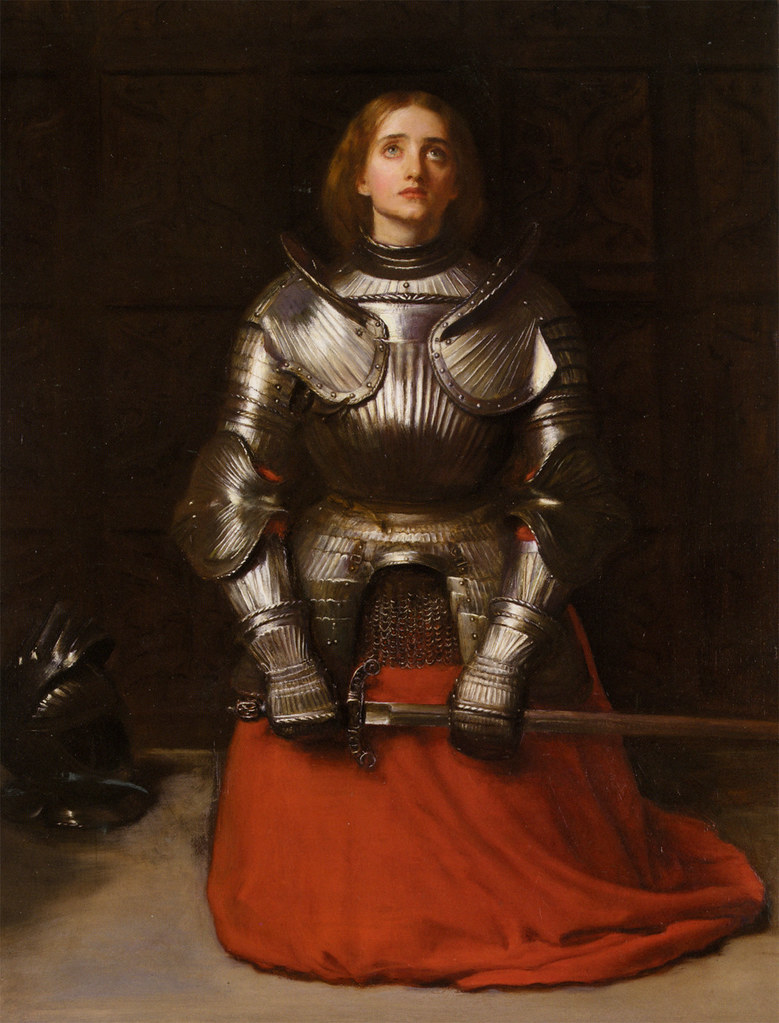St. Joan of Arc (Jeanna d’Arc), “Maiden of Orléans”, was only 19 years old when she was burnt at the stake after being accused of heresy, witchcraft, and violating divine law for dressing like a man. 20 years later, her name was cleared. 500 years after her death, Joan was canonized as a patron saint of the Roman Catholic Church and is today seen as a national hero of France for her role in the Hundred Years’ War and her insistence on the coronation of Charles VII of France.
Believed to have been born January 6, 1412, in Domrémy-la-Pucelle, France, Joan of Arc was a normal child of peasant parents. She lived on a farm with her family and spent her time taking care of the animals, sewing, and spinning. She never attended school, nor ever learned how to read or write, but was very serious in her Catholic faith and devout to studying the religion’s teachings. At age 13, Joan claimed for the first time to have received divine instruction from Saints Micheal, Catherine, and Margaret. They told her to drive the English out of the country and to help Charles VII be named as king. At the time, the English and their allies controlled much of France. Along with the English threats, a faction loyal to the Duke of Burgundy challenged the right of Charles of Orléans to the French throne. Joan decided she was sent by God on a very important mission and successfully got out of an arranged marriage her father tried to set up and instead took a vow of chastity to complete her mission. Joan continued to be insistent of her visions, and at the age of 16, correctly predicted the outcome of a battle to a French commander who then finally agreed to take her Charles.
Having won Charles over and gaining a band of followers, Joan was sent to the Siege of Orléans. She cut her hair short and wore men’s clothing for the 11-day journey to Chinon, the site of the crown prince’s palace. After promising to see him crowned king, Joan asked Charles for an army to lead to Orléans. During her time as a military leader, Joan sent a defiant letter to the English, led many French assaults upon the English, which drove the Anglo-Burgundians to retreat across the Loire River, and escorted Charles across enemy territory to Reims, taking towns along the way and enabling Charles’ coronation as King Charles VII in July 1429.
In the spring of 1430, King Charles sent Joan to confront a Burgundian assault on Compiège. While attempting to defend the town and its people, Joan was thrown off her horse and left outside the town as the gates closed. The Burgundians captured her and brought her to the castle of Bouvreuil which was occupied by the English.
After being captured, Joan was put on trial. From the Burgundian point of view, the reason for the trial was to get rid of the young military leader and to discredit King Charles VII. Joan was ordered to answer about 70 charges brought against her, which included heresy, witchcraft, and dressing like a man. Charles made no attempt to help Joan or negotiate her release in hopes of distancing himself from an accused heretic and witch. After a year of captivity and threat of death, Joan reluctantly signed a confession denying she ever received divine instruction. She also agreed to not wear any more men’s clothing and to not disagree with the divine word. However, days later she was caught donning men’s clothing again and authorities made no hesitation in pronouncing her death sentence. On the morning of May 30, 1431, Joan was taken to the old marketplace of Rouen and burned at the stake at the age of 19, where her remains were thereafter thrown into the Seine River.
Joan’s fame continued to rise after her death, as 20 years after her passing, a new trial ordered by King Charles cleared her name of criminal affiliation. Joan has influenced many works of art and literature over the centuries, including the silent film The Passion of Joan of Arc and Friedrich Schiller’s 1801 play, The Maid of Orleans. In 1909, Joan was beatified in the Notre Dame cathedral in Paris, France by Pope Pius X. A statue of Jeanna d’Arc was built as a tribute to her legacy in the cathedral. 500 years after her death, Joan of Arc was canonized by Pope Benedict XV and was declared a patron saint of France two years later.
During the medieval period, Joan believed that God had chosen her to lead France to victory and had sent the message via divine visions but it’s believed today, with the knowledge of modern medicine, that Joan could have had various medical conditions such as epilepsy, a temporal lobe tuberculoma, or schizophrenia. The non-religious view of Joan of Arc today is as an icon of feminism who challenged gender roles, and who acted independently and individually. She continues to influence music, theater, literature, films, and sculpture. While seen as crazy, unstable, and defiant during her short life, Joan of Arc is remembered beautifully today as a hero to many.


























































































































